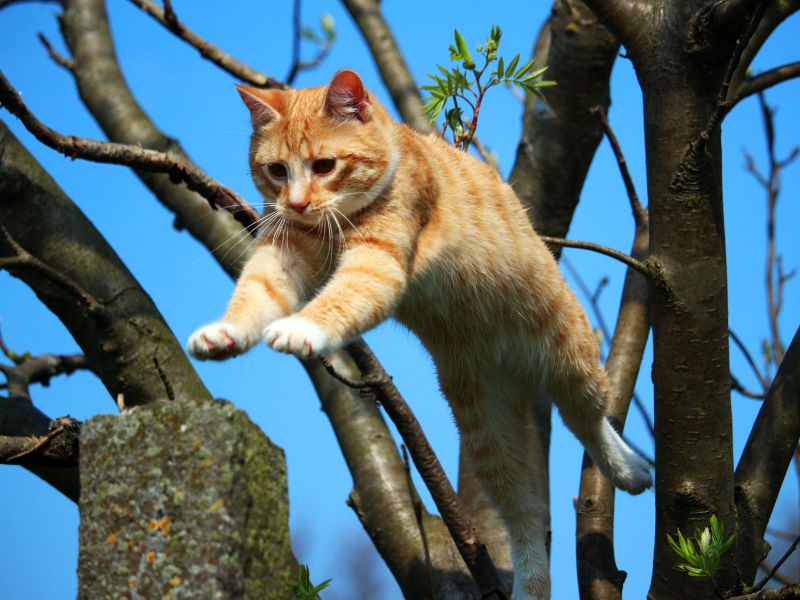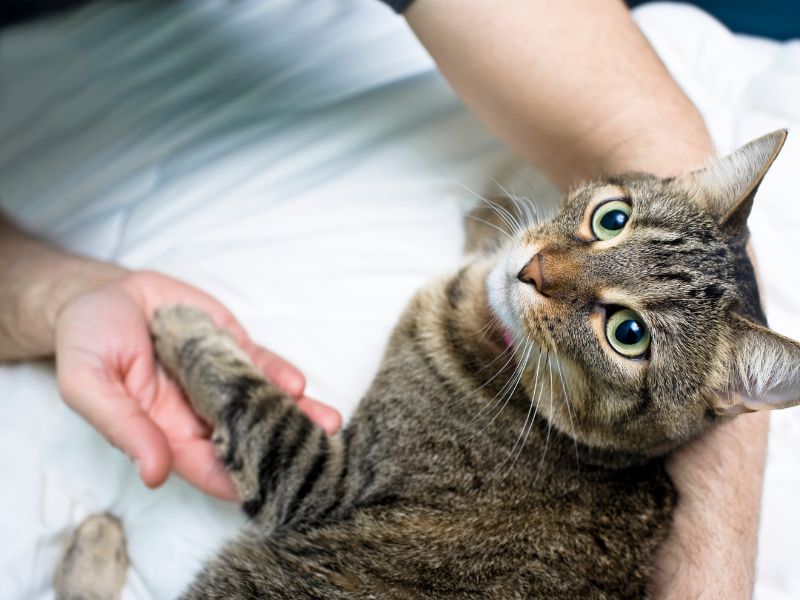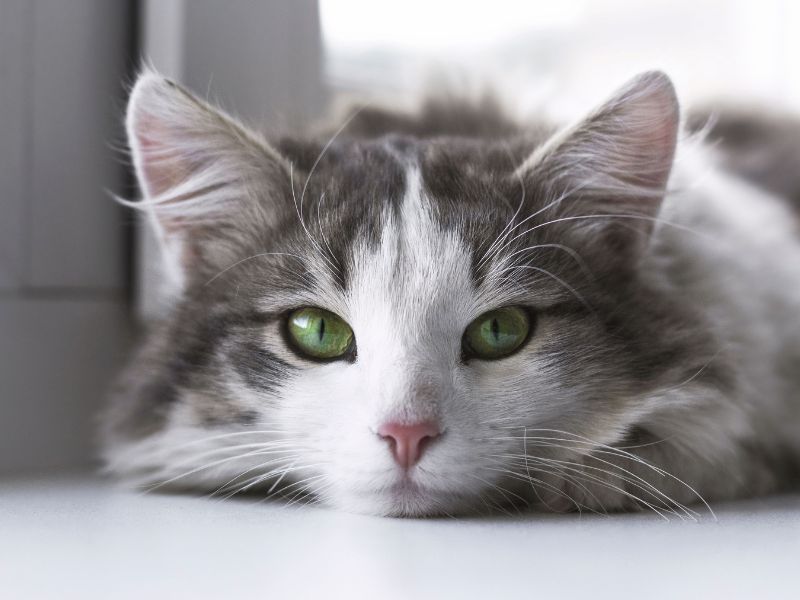Cats are mysterious creatures that have been domesticated for thousands of years. They have a certain charm that humans find irresistible. But how much do we really know about these fascinating creatures? In this article, we will explore 20 amazing facts and myths about cats that will surprise and amaze you.
Fact 1: Cats Have Incredible Jumping Abilities
One of the most amazing facts about cats is their incredible jumping abilities. They can jump up to six times their own body length, which is a feat that no other animal can match. This ability is due to their powerful back legs, which allow them to launch themselves into the air with incredible force.
But why do cats need to be able to jump so high? Well, in the wild, cats use their jumping abilities to catch prey and to escape from predators. Even domesticated cats still have this instinctual behavior, which is why you might see your cat jumping up to catch a toy or climbing to the top of a bookshelf.
Fact 2: Cats Can Predict Earthquakes
There is a popular belief that cats can predict earthquakes. This myth has been around for centuries, and many people swear by it. The theory goes that cats are able to detect changes in the earth’s magnetic field, which can indicate an impending earthquake.
While there is no scientific evidence to support this theory, there have been many reports of cats behaving strangely before earthquakes. Some cats have been known to become agitated or vocal, while others have been seen hiding or seeking out their owners. Whether or not cats can really predict earthquakes is still up for debate, but it’s definitely an interesting myth to consider.
Fact 3: Cats Have Flexible Spines
If you’ve ever watched a cat stretch, you’ve probably noticed how flexible they are. Cats have incredibly flexible spines that allow them to contort their bodies in all sorts of ways. They can twist and turn in mid-air, and they can even squeeze through small openings that seem impossible for their size.
This flexibility is due to the fact that cats have 30 vertebrae in their spine, which is more than any other mammal except for the giraffe. Additionally, their vertebrae are connected by flexible ligaments and muscles, which allow them to move in a wide range of directions.
Fact 4: Cats Have a Unique Way of Drinking
Have you ever watched a cat drink water? If so, you might have noticed that they don’t just lap up the water like a dog would. Instead, they use their tongue to create a column of water that they then capture with their jaws.
This unique drinking style is due to the fact that cats have a rough, sandpaper-like tongue that is covered in tiny spines called papillae. When a cat dips its tongue into water, the spines create a funnel that draws the water up into their mouth. This method of drinking is incredibly efficient, allowing cats to take in a large amount of water in just a few laps.

Fact 5: Cats Can See in the Dark
Another fascinating fact about cats is their ability to see in the dark. Cats have large eyes that are specially adapted to low-light conditions. Their pupils can dilate to let in more light, and their retinas contain a high concentration of light-sensitive cells called rods.
This adaptation allows cats to see in just one-sixth of the light that humans need to see. Additionally, cats have a reflective layer behind their retina called the tapetum lucidum, which helps to amplify the available light. This is why cats’ eyes seem to glow in the dark when light is shone on them.
Myth 1: Cats Always Land on Their Feet
There is a common myth that cats always land on their feet, no matter how far they fall. While it is true that cats are very agile and have a natural instinct to right themselves in mid-air, they are not invincible.
If a cat falls from a great height, it can still sustain serious injuries or even die. This is because the impact of the fall can cause internal damage, even if the cat lands on its feet. Additionally, cats can misjudge distances and angles, which can cause them to land awkwardly.
Myth 2: Cats Are Aloof and Independent
While it’s true that cats have a reputation for being aloof and independent, this stereotype is not entirely accurate. Many cats are actually very social creatures that crave attention and affection.
The reason for this misconception is that cats are more subtle in their displays of affection than dogs, for example. They might not wag their tails or jump up to greet you, but they will often rub against you or purr when you pet them. Additionally, cats are very good at reading human emotions, and they will often seek out their owners when they sense that they need comfort.
Myth 3: Cats Are Not Loyal
Another common myth about cats is that they are not loyal to their owners. This belief stems from the fact that cats are more independent than dogs and often seem to have a mind of their own.
However, cats can be very loyal to their owners in their own way. They might not follow you around like a dog would, but they will often wait for you to come home and greet you with affection. Additionally, cats are very good at recognizing their owners’ voices and scents, and they will often respond to them in a positive way.
Fact 6: Cats Have Excellent Hearing
Cats have incredibly sensitive ears that are capable of picking up even the faintest sounds. They can hear frequencies that are too high for human ears to detect, and they can even hear sounds that are too low for us to hear.
This adaptation allows cats to hunt prey in the wild and to monitor their environment for potential threats. Additionally, cats are very good at localizing sounds, which means that they can pinpoint the exact location of a sound source.
Fact 7: Cats Are Natural Hunters
It’s no secret that cats have a strong instinct to hunt. Even domesticated cats will often stalk and pounce on toys or insects. This behavior is due to the fact that cats are natural predators that evolved to hunt small prey in the wild.
Cats have a number of physical adaptations that make them excellent hunters, including sharp claws, retractable claws, and powerful muscles. Additionally, cats have excellent eyesight and hearing, which allow them to detect prey from a distance.
Fact 8: Cats Have Unique Personalities
Cats are not all the same. Just like humans, each cat has its own unique personality that is shaped by genetics and environment. Some cats are outgoing and friendly, while others are more reserved and independent.
Additionally, cats have a range of emotional expressions that they use to communicate with humans and other cats. For example, cats will often purr when they are content or seeking attention, and they will hiss or growl when they feel threatened or angry.
Fact 9: Cats Have Been Domesticated for Thousands of Years
Cats have been domesticated for thousands of years, dating back to ancient Egypt. In fact, cats were so highly regarded in ancient Egypt that they were worshipped as gods.
Over time, cats became valued for their ability to control pests like rodents, and they became popular pets in many parts of the world. Today, cats are one of the most popular pets in the world, with an estimated 600 million cats living with humans.

Fact 10: Cats Sleep a Lot
Cats are known for their love of napping, and for good reason. Cats sleep an average of 15 hours a day, with some cats sleeping up to 20 hours a day.
This behavior is due to the fact that cats are natural predators that need to conserve energy in order to hunt. Additionally, cats are crepuscular animals, which means that they are most active at dawn and dusk. This means that they need to rest during the day in order to be ready for their most active periods.
Fact 11: Cats Have a Powerful Sense of Smell
Cats have an incredibly powerful sense of smell that is up to 14 times stronger than that of humans. They use their sense of smell to detect prey, to mark their territory, and to communicate with other cats.
Additionally, cats have a unique organ in the roof of their mouth called the vomeronasal organ, which allows them to detect pheromones. Pheromones are chemical signals that are used to communicate with other animals of the same species. This organ is why you might see your cat open its mouth and make a strange face when it encounters a new smell.
Fact 12: Cats Have Been Sent into Space
Believe it or not, a cat has been sent into space. In the 1960s, the French space program launched a mission that sent Felicette, a female cat, into orbit.
The goal of this mission was to study the effects of space travel on living organisms. While Felicette survived the mission, she was unfortunately euthanized shortly after, so scientists could examine how her body was affected by her flight. Her sacrifice helped to pave the way for human space travel.
Fact 13: Cats Have a Unique Paw Print
Just like humans have unique fingerprints, cats have unique paw prints. Each cat’s paw print is as unique as a human fingerprint, and it can be used to identify individual cats.
Additionally, cats have scent glands in their paws that they use to mark their territory. When a cat scratches a surface, it leaves behind both its scent and its unique paw print.
Fact 14: Cats Can Get Hairballs
If you own a cat, you are probably familiar with hairballs. Hairballs occur when a cat ingests too much hair while grooming itself.
While hairballs are not usually harmful, they can cause discomfort and even vomiting in some cats. To help prevent hairballs, it’s important to groom your cat regularly and to feed them a diet that is high in fiber.

See Also: How to Introduce a New Cat to Your Existing Cat
And: How to Correct Common Cat Behavior Problems
Fact 15: Cats Have a Unique Way of Communicating
Cats have a unique way of communicating with humans and other cats. They use a variety of vocalizations, body language, and scent marking to convey their thoughts and emotions.
For example, cats will often meow to get their owners’ attention or to ask for food. They will also use body language to communicate, such as arching their backs when they feel threatened or rubbing against their owners when they want attention. Additionally, cats will use scent marking to communicate with other cats, such as rubbing their faces against objects to leave their scent behind.
Fact 16: Cats Can Change Their Meows
If you’ve ever owned a cat, you might have noticed that they have different meows for different situations. For example, they might have a high-pitched meow when they are hungry, and a lower-pitched meow when they want attention.
This ability to change their meows is due to the fact that cats are very good at reading human emotions and responding to them. They have learned that different meows elicit different responses from their owners, and they will adjust their meows accordingly.
Fact 17: Cats Have a Third Eyelid
Cats have a third eyelid, also known as a nictitating membrane, that helps to protect and lubricate their eyes. This membrane is transparent and can be seen in the inner corner of a cat’s eye.
Additionally, cats have a unique blinking pattern that is different from that of humans. They will often blink slowly and purposefully when they are relaxed and comfortable, which is a sign that they trust their environment.
Fact 18: Cats Have a Unique Digestive System
Cats have a unique digestive system that is designed to handle a high-protein diet. They have a short digestive tract that allows them to quickly digest and absorb nutrients from their food.
Additionally, cats have a very low thirst drive, which means that they need to get most of their water from their food. This is why it’s important to feed your cat a high-quality diet that is rich in protein and moisture.
Fact 19: Cats Have Been the Subject of Many Famous Works of Art
Cats have been the subject of many famous works of art throughout history. From ancient Egyptian paintings to modern-day internet memes, cats have captured the hearts and imaginations of artists and writers alike.
Some of the most famous works of art featuring cats include “The Cat in the Hat” by Dr. Seuss, “The Black Cat” by Edgar Allan Poe, and “The Cheshire Cat” from Lewis Carroll’s “Alice’s Adventures in Wonderland.”
Fact 20: Cats Can Improve Your Health
Last but not least, owning a cat can actually be good for your health. Studies have shown that petting a cat can lower your blood pressure and reduce stress.
Additionally, owning a cat can help to reduce the risk of heart attack and stroke, as well as improve your overall mood and mental health. So, if you needed another reason to love your furry friend, there it is!
Conclusion
Cats are amazing creatures that have captured our hearts and imaginations for thousands of years. Whether you are a cat lover or just curious about these fascinating creatures, there is no shortage of interesting facts and myths to explore. From their incredible jumping abilities to their unique personalities, cats continue to surprise and inspire us every day.

